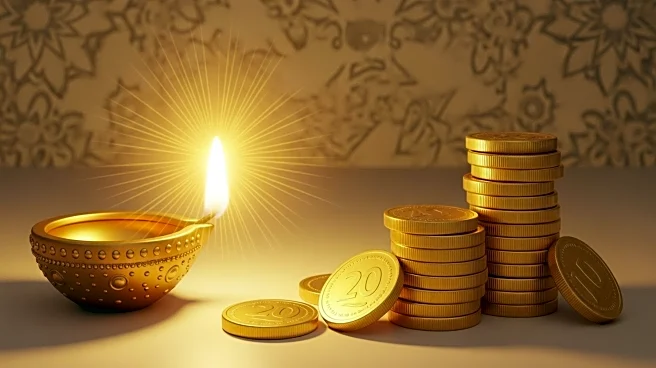What's Happening?
Ahead of the Hindu festival of Diwali, the jewellery market in Delhi's Lajpat Nagar is bustling with activity despite soaring gold prices. Traditionally, Diwali and Dhanteras are considered auspicious
times for purchasing gold, leading to a surge in demand for gold and silver coins, bars, and jewellery. However, with gold prices reaching $1,440 for 10 grams, consumers are adjusting their buying habits. Many are opting for lighter jewellery or investing in gold and silver for financial purposes rather than purely for adornment. This shift is reflected in the World Gold Council's data, which shows a decline in jewellery's share of gold demand from 80% to 64%, while investment demand has risen from 19% to 35%. The Reserve Bank of India has also increased its gold holdings, contributing to the demand.
Why It's Important?
The shift in consumer behavior towards gold investment rather than jewellery highlights broader economic trends in India. As gold prices rise, consumers are seeking ways to preserve wealth, reflecting concerns over economic stability and inflation. This trend could impact the jewellery industry, which may need to adapt to changing consumer preferences. Additionally, the Reserve Bank of India's increased gold holdings indicate a strategic move to diversify foreign exchange reserves and reduce reliance on the dollar, which could have implications for India's economic policy and stability. The ongoing demand for gold, despite high prices, underscores its cultural significance and the role it plays in financial security for Indian households.
What's Next?
With the festive and wedding season underway, retail demand for gold is expected to remain strong, although the volume of purchases may decrease due to high prices. The affluent classes are likely to continue buying, while lower-income families may face challenges. Jewellers may need to innovate further to cater to changing consumer preferences, such as designing lighter jewellery that appears elaborate. The Reserve Bank of India's strategy to increase gold reserves could continue, potentially influencing global gold demand and prices. As consumers navigate high prices, the market may see increased interest in digital gold and exchange-traded funds as alternative investment options.
Beyond the Headlines
The cultural affinity for gold in India suggests that demand will persist despite economic fluctuations. Gold's role as a symbol of wealth and prosperity is deeply ingrained in Indian society, and its long-term returns have historically provided financial security. This cultural and economic dynamic may continue to influence consumer behavior and market trends. Additionally, the shift towards investment in gold could have broader implications for financial markets and economic policy, as households seek to balance traditional practices with modern financial strategies.











